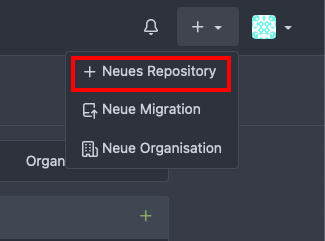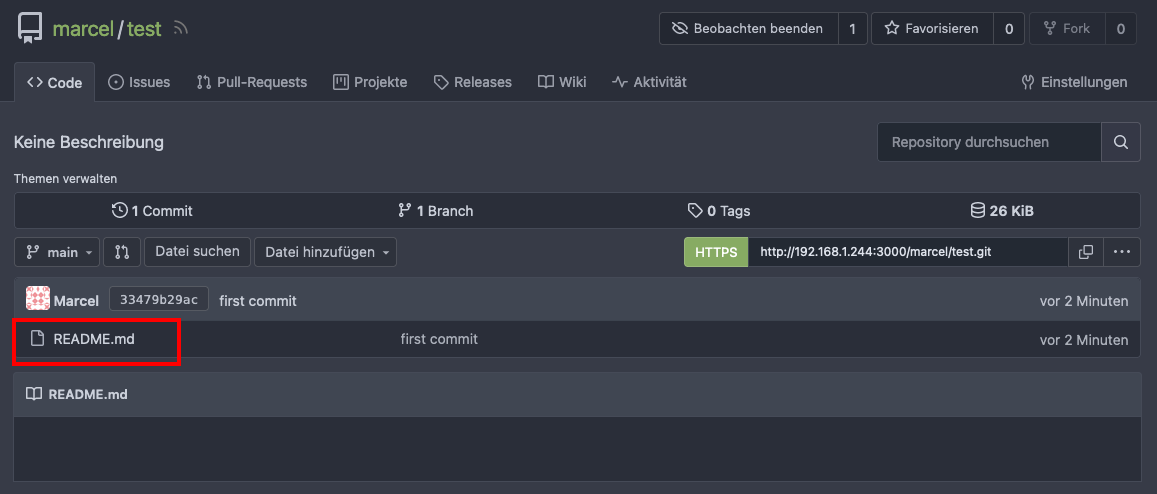Extra part: First steps
Requirements
Git must be installed and can be downloaded here for almost all operating systems or is usually already part of your favorite distribution. Under FreeBSD e.g. a pkg install git or under Debian an apt install git is sufficient.
Attention, these steps only work if the 2FA authentication is not yet activated. If this is the case for you, then the specification with the username/password is not sufficient and we need additional steps.
However, the diversity of Git is much higher, especially when it comes to simultaneous local and online edits. But there are many more online resources.
Last updated:
- 05.01.2024: Various minor adjustments
- 20.05.2023: Initial document
Create empty project
New system, new luck. The first repository is quickly created.
However, in order to be able to use it online directly to its full extent, Initialization must be activated during creation.


Only with this, files can then be created or uploaded directly after the project creation via the Gitea page in the browser and then edited.
Set up local git
If the files created online from a repository are to be edited locally after all, they can be downloaded.
A repository always needs a dedicated folder locally, where the configuration and the files are stored.
For this, the following steps are necessary once:
mkdir REPOSITORYNAME
cd REPOSITORYNAME
git init
git config user.email "EMAIL"
git config user.name "NAME"
git remote add origin http://GITEAIP:3000/USERNAME/REPOSITORYNAME.gitThis creates:
- create and prepare the REPOSITORYNAME folder for git (
mkdir REPOSITORYNAME,cd REPOSITORYNAME,git init) , - set the name/email of the author (
git config user.email "EMAIL",git config user.name "NAME") , - set the target as alias
origin(git remote add origin http://GITEAIP:3000/USERNAME/REPOSITORYNAME.git) ,
Download files
cd REPOSITORYNAME
git pull origin mainThis will download:
- All files from the source
originand the main branchmainare downloaded (git pull origin main), at the first time also username and password are requested.mainis the current working version, so to speak. To keep the local files always up to date it is sufficient to repeatgit pull origin mainin the folder REPOSITORYNAME before updating files locally.
Upload files
If there were local changes, they will be uploaded back to the git after editing.
The three commands are always necessary for this:
git stage .
git commit -m "COMMENT"
git push origin mainThis will:
- All local changes are made known (
git stage .), alternatively this can be only one file (git stage FILE). - Each change is documented by a comment (
git commit -m "COMMENT") - Then everything is uploaded to the target
originin the branchmain(git push origin main)
Migration of existing files
Let's say there is an existing directory on your machine that you want to migrate to Git.
For this it is sufficient to create a new repository, but here you should do it without the initialization, .....

... which is waiting for the first "contents".
Make local files and git known
On your computer, change to the directory with the existing files via console and follow these commands:
cd REPOSITORYNAME
git init
git config user.email "EMAIL"
git config user.name "NAME"
git remote add origin http://GITEAIP:3000/USERNAME/REPOSITORYNAME.gitThis will prepare:
- prepare the REPOSITORYNAME folder for git (
cd REPOSITORYNAME,git init) , - set the name/email of the author (
git config user.email "EMAIL",git config user.name "NAME") , - set the target as alias
origin(git remote add origin http://GITEAIP:3000/USERNAME/REPOSITORYNAME.git) ,
Initial file upload
git checkout -b main
git add .
git commit -m "First commit"
git push origin mainThis will:
- all files in the folder are made known (
git checkout -b main,git add .) , - files with a comment (
git commit -m "COMMENT"), so that they are versioned and changes are documented - and uploaded to the target
originbranchmain(git push origin main)
Then the repository is also fully usable online.
In the example, my test directory contains only a single README.md file.

For further changes, the steps described above are necessary to [upload](#upload files) or [download](#download files) files.
Voilá
